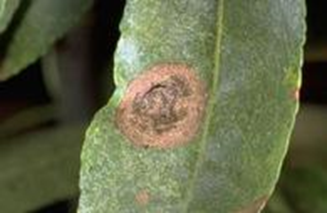Adapted from the article “Alternaria leaf spot and leaf rust of almond” by Joseph Connell, UCCE Farm Advisor, Butte County, and Dr. Jim Adaskaveg, Professor, Department of Plant Pathology and Microbiology, University of California Riverside, in the July, 2013 Sacramento Valley Almond Newsletter
Alternaria leaf spot is becoming more prevalent in the Sacramento Valley. The disease is favored by high humidity and leaf wetness. Recent extended wet springs and changes in cultural practices (higher density plantings, micro-sprinkler irrigation with longer, more frequent sets) are contributing to higher humidity, more accumulated leaf wetness hours (e.g., dew, rainfall, irrigation, etc.) resulting in higher disease incidence.
Alternaria leaf spot is a fungal disease caused by a complex of Alternaria species including A. alternata, A. arborescens and A. tenuissima. Alternaria leaf spot appears as up to half inch diameter brown spots (Figure 1) on leaves. Leaf spots turn black as the fungus produces spores. Alternaria leaf spot develops most rapidly in the hot summer months, and can almost completely defoliate trees by mid-summer.

Figure 1. Alternaria leaf spot.
Disease management. Relying entirely on fungicides to control this disease can be costly and increases the risk of resistance development. Consider an integrated approach including:
- Planting less susceptible cultivars. Varieties that are most susceptible include Carmel, Sonora, Monterey, Winters and Butte.
- Select a planting design which allows for air circulation. Orchards planted with rows in an east/west direction typically have more severe disease than orchards with rows in a north/south orientation.
- Prune and train trees to allow air circulation and reduce dew formation.
- Practice good foliar disease and mite control to minimize stressed and injured leaf tissue.
- Irrigate less frequently with larger volumes of water to minimize relative humidity and subsequent leaf wetness.
- Manage the orchard floor to reduce relative humidity and the amount of senescing tissue colonized by Alternaria
Disease resistance against QoIs (strobilurins – FRAC group 11) and SDHIs (FRAC group 7) occurs in the Sacramento Valley. Late-spring/early-summer applications should alternate materials to manage resistance. New materials (Quash, Inspire Super – both containing FRAC group 3) and Ph-D (FRAC group 19) must be used in rotations and mixtures for resistance management. Newer SDHI fungicides (different sub-groups) such as Luna Sensation, Luna Experience, and Merivon (Fontelis should always be mixed with a DMI fungicide) are proving to be highly effective but the potential for resistance is also extremely high. Combination tank mixtures, pre-mixtures, and rotations will be required for preventing disease resistance to the newer SDHI compounds.


Leave a Reply